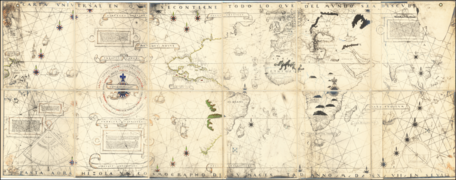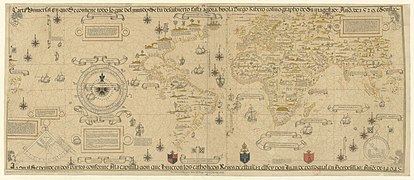Early world maps
The earliest knownworld mapsdate toclassical antiquity,the oldest examples of the 6th to 5th centuriesBCEstill based on theflat Earthparadigm. World maps assuming aspherical Earthfirst appear in theHellenistic period.The developments ofGreek geographyduring this time, notably byEratosthenesandPosidoniusculminated in the Roman era, withPtolemy's world map(2nd century CE), which would remain authoritative throughout theMiddle Ages.Since Ptolemy, knowledge of the approximate size of the Earth allowed cartographers to estimate the extent of their geographical knowledge, and to indicate parts of the planet known to exist but not yet explored asterra incognita.
With theAge of Discovery,during the 15th to 18th centuries, world maps became increasingly accurate; exploration of Antarctica, Australia, and theinterior of Africaby western mapmakers was left to the 19th and early 20th century.
Antiquity
[edit]Bronze Age Saint-Bélec slab
[edit]TheSaint-Bélec slabdiscovered in 1900 byPaul du Châtellier,in Finistère, France, is dated to between 1900 BCE and 1640 BCE. A recent analysis, published in the Bulletin of the French Prehistoric Society, has shown that the slab is a three-dimensional representation of theRiver Odetvalley in Finistère, France. This would make the Saint-Bélec slab the oldest known map of a territory in the world. According to the authors, the map probably was not used for navigation, but rather to show the political power and territorial extent of a local ruler’s domain of the earlyBronze age.[1][2][3][4]
BabylonianImago Mundi(c. 6th c. BCE)
[edit]
A Babylonian world map, known as theImago Mundi,is commonly dated to the 6th century BCE.[5] The map as reconstructed byEckhard UngershowsBabylonon theEuphrates,surrounded by a circular landmass includingAssyria,Urartu(Armenia)[6]and several cities, in turn surrounded by a "bitter river" (Oceanus), with eight outlying regions (nagu) arranged around it in the shape of triangles, so as to form a star. The accompanying text mentions a distance of sevenberubetween the outlying regions. The descriptions of five of them have survived:[7]
- The third region is where "the winged bird ends not his flight", i.e., cannot reach.
- On the fourth region "the light is brighter than that of sunset or stars": it lay in the northwest, and after sunset in summer was practically in semi-obscurity.
- The fifth region, due north, lay in complete darkness, a land "where one sees nothing", and "the sun is not visible".
- The sixth region, "where a horned bull dwells and attacks the newcomer".
- The seventh region lay in the east and is "where the morning dawns".
Anaximander (c. 610–546 BCE)
[edit]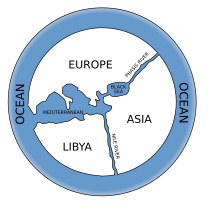
Anaximander(died c. 546 BCE) is credited with having created one of the first maps of the world,[8]which was circular in form and showed the known lands of the world grouped around theAegean Seaat the center. This was all surrounded by the ocean.
Hecataeus of Miletus (c. 550–476 BCE)
[edit]
Hecataeus of Miletus(diedc. 476BCE) is credited with a work entitledPeriodos Ges( "Travels round the Earth" or "World Survey" ), in two books each organized in the manner of aperiplus,a point-to-point coastal survey. One, onEurope,is essentially a periplus of the Mediterranean, describing each region in turn, reaching as far north asScythia.The other book, onAsia,is arranged similarly to thePeriplus of the Erythraean Seaof which a version of the 1st century CE survives. Hecataeus described the countries and inhabitants of the known world, the account ofEgyptbeing particularly comprehensive; the descriptive matter was accompanied by a map, based uponAnaximander's map of the Earth, which he corrected and enlarged. The work only survives in some 374 fragments, by far the majority being quoted in the geographical lexicon theEthnica,compiled byStephanus of Byzantium.
Eratosthenes (276–194 BCE)
[edit]
Eratosthenes(276–194 BCE) drew an improved world map, incorporating information from the campaigns ofAlexander the Greatand his successors.Asiabecame wider, reflecting the new understanding of the actual size of the continent. Eratosthenes was also the first geographer to incorporate parallels and meridians within his cartographic depictions, attesting to his understanding of the spherical nature of the Earth.
Posidonius (c. 135–51 BCE)
[edit]
Posidonius(or Poseidonius) ofApameia(c. 135–51 BCE) was a GreekStoicphilosopher[10]who traveled throughout the Roman world and beyond and was a celebratedpolymaththroughout the Greco-Roman world, likeAristotleandEratosthenes.His work "about the ocean and the adjacent areas" was a general geographical discussion, showing how all the forces had an effect on each other and applied also to human life. He measured the Earth's circumference by reference to the position of the starCanopus.His measure of 240,000stadiatranslates to 24,000 miles (39,000 km), close to the actual circumference of 24,901 miles (40,074 km).[11]He was informed in his approach by Eratosthenes, who a century earlier used the elevation of the Sun at different latitudes. Both men's figures for the Earth's circumference were uncannily accurate, aided in each case by mutually compensating errors in measurement. However, the version of Posidonius' calculation popularised byStrabowas revised by correcting the distance between Rhodes and Alexandria to 3,750 stadia, resulting in a circumference of 180,000 stadia, or 18,000 miles (29,000 km).[12]Ptolemydiscussed and favored this revised figure of Posidonius over Eratosthenes in hisGeographia,and during theMiddle Agesscholars divided into two camps regarding the circumference of the Earth, one side identifying with Eratosthenes' calculation and the other with Posidonius' 180,000 stadion measure, which is now known to be about 33% too low. This was the number used byChristopher Columbusto underestimate the distance to India as 70,000 stades.[13]
Strabo (c. 64 BCE – 24 CE)
[edit]Strabo is mostly famous for his 17-volume workGeographica,which presented a descriptive history of people and places from different regions of the world known to his era.[14]TheGeographicafirst appeared in Western Europe in Rome as a Latin translation issued around 1469. Although Strabo referenced the antique Greek astronomers Eratosthenes andHipparchusand acknowledged their astronomical and mathematical efforts towards geography, he claimed that a descriptive approach was more practical.Geographicaprovides a valuable source of information on the ancient world, especially when this information is corroborated by other sources. Within the books ofGeographicais a map of Europe. Whole world maps according to Strabo are reconstructions from his written text.
Pomponius Mela (c. 43 CE)
[edit]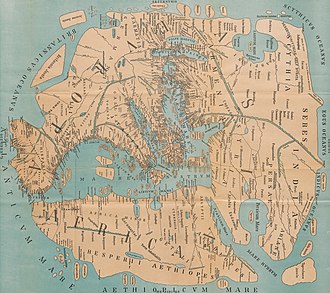
Pomponius is unique among ancient geographers in that, after dividing the Earth into five zones, of which two only were habitable, he asserts the existence ofantichthones,people inhabiting the southern temperate zone inaccessible to the folk of the northern temperate regions due to the unbearable heat of the intervening torrid belt. On the divisions and boundaries ofEurope,AsiaandAfrica,he repeats Eratosthenes; like all classical geographers fromAlexander the Great(exceptPtolemy) he regards theCaspian Seaas an inlet of the Northern Ocean, corresponding to the Persian (Persian Gulf) and Arabian (Red Sea) gulfs on the south.
Marinus of Tyre (c. 120 CE)
[edit]Marinus of Tyre's world maps were the first in theRoman Empireto showChina.Around 120 CE, Marinus wrote that the habitable world was bounded on the west by theFortunate Islands.The text of his geographical treatise however is lost. He also invented theequirectangular projection,which is still used in map creation today. A few of Marinus' opinions are reported by Ptolemy. Marinus was of the opinion that theOkeanoswas separated into an eastern and a western part by the continents (Europe,Asia and Africa). He thought that the inhabited world stretched in latitude fromThule(Shetland) toAgisymba(Tropic of Capricorn) and in longitude from theIsles of the BlessedtoShera (China).Marinus also coined the term Antarctic, referring to the opposite of theArctic Circle.His chief legacy is that he first assigned to each place a properlatitudeandlongitude;he used a "Meridian of theIsles of the Blessed(Canary IslandsorCape Verde Islands) "as thezero meridian.
Ptolemy (c. 150)
[edit]

Surviving texts ofPtolemy'sGeography,first composedc. 150,note that he continued the use of Marinus's equirectangular projection for its regional maps while finding it inappropriate for maps of theentire known world.Instead, in Book VII of his work, he outlines three separate projections of increasing difficulty and fidelity. Ptolemy followed Marinus in underestimating the circumference of the world; combined with accurate absolute distances, this led him to also overestimate the length of theMediterranean Seain terms ofdegrees.Hisprime meridianat theFortunate Isleswas therefore around 10 actual degrees further west ofAlexandriathan intended, a mistake that was corrected byAl-Khwārizmīfollowing the translation ofSyriaceditions of Ptolemy intoArabicin the 9th century. The oldest surviving manuscripts of the work date toMaximus Planudes's restoration of the text a little before 1300 atChora MonasteryinConstantinople(Istanbul); surviving manuscripts from this era seem to preserve separate recensions of the text which diverged as early as the 2nd or 4th century. A passage in some of the recensions credits anAgathodaemonwith drafting a world map, but no maps seem to have survived to be used by Planude's monks. Instead, he commissioned new world maps calculated from Ptolemy's thousands of coordinates and drafted according to the text's 1st[15]and 2nd projections,[16]along with the equirectangular regional maps. A copy was translated intoLatinbyJacobus AngelusatFlorencearound 1406 and soon supplemented with maps on the 1st projection. Maps using the 2nd projection were not made in Western Europe untilNicolaus Germanus's 1466 edition.[17]Ptolemy's 3rd (and hardest) projection does not seem to have been used at all beforenew discoveriesexpanded the known world beyond the point where it provided a useful format.[17]
Cicero'sDream of Scipiodescribed the Earth as a globe of insignificant size in comparison to the remainder of the cosmos. Many medieval manuscripts ofMacrobius'Commentary on the Dream of Scipioinclude maps of the Earth, including theantipodes,zonal maps showing thePtolemaic climatesderived from the concept of a spherical Earth and a diagram showing the Earth (labeled asglobus terrae,the sphere of the Earth) at the center of the hierarchically ordered planetary spheres.[18][19]
Tabula Peutingeriana(4th century)
[edit]TheTabula Peutingeriana(Peutinger table) is anitinerariumshowing thecursus publicus,the road network in theRoman Empire.It is a 13th-century copy of an original map dating from the 4th century, covering Europe, parts of Asia (India) and North Africa. The map is named afterKonrad Peutinger,a German 15th–16th century humanist and antiquarian. The map was discovered in a library inWormsbyConrad Celtes,who was unable to publish his find before his death, and bequeathed the map in 1508 to Peutinger. It is conserved at theÖsterreichische Nationalbibliothek,Hofburg,Vienna.
Middle Ages
[edit]Cosmas Indicopleustes' Map (6th century)
[edit]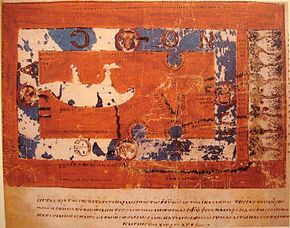
Around 550Cosmas Indicopleusteswrote the copiously illustratedChristian Topography,a work partly based on his personal experiences as a merchant on the Red Sea and Indian Ocean in the early 6th century. Though hiscosmogonyis refuted by modern science, he has given a historic description of India andSri Lankaduring the 6th century, which is invaluable to historians. Cosmas seems to have personally visited the Kingdom ofAxumin modernEthiopiaandEritrea,as well asIndiaandSri Lanka.In 522 CE, he visited theMalabar Coast(South India). A major feature of hisTopographyis Cosmas' worldview that theworldisflat,and that theheavensform the shape of a box with a curved lid, a view he took from unconventional interpretations ofChristianscripture.Cosmas aimed to prove that pre-Christian geographers had been wrong in asserting that the earth was spherical and that it was in fact modelled on theTabernacle,the house of worship described toMosesby God during the Jewish Exodus from Egypt.
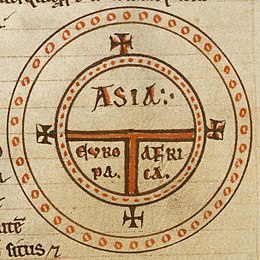
Isidore of Sevilla'sT and O map(c. 636)
[edit]The medievalT and O mapsoriginate with the description of the world in theEtymologiaeofIsidore of Seville(died 636). This qualitative and conceptual type of medievalcartographyrepresents only the top-half of a spherical Earth.[20]It was presumably tacitly considered a convenientprojectionof the inhabited portion of the world known in Roman and Medieval times (that is, thenorthern temperatehalf of the globe). TheTis theMediterranean,dividing the threecontinents,Asia,EuropeandAfrica,and theOis the surroundingOcean.Jerusalemwas generally represented in the center of the map. Asia was typically the size of the other two continents combined. Because the sun rose in the east, Paradise (the Garden of Eden) was generally depicted as being in Asia, and Asia was situated at the top portion of the map.
Albi Mappa Mundi (8th century)
[edit]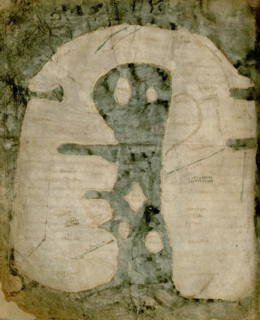
TheMappa mundi of Albiis a medieval map of the world, included in a manuscript of the second half of the 8th century, preserved in the old collection of the library Pierre-Amalric inAlbi,France.[21]This manuscript comes from the chapter library of the Sainte-CécileAlbi Cathedral.The Albi Mappa Mundi was inscribed in October 2015 in theMemory of the World ProgrammeofUNESCO.[22]
The manuscript bearing the card contains 77 pages. It is named in the eighteenth century "Miscellanea"(Latin word meaning" collection "). This collection contains 22 different documents, which had educational functions. The manuscript, aParchmentprobably made from a goat or sheep skin, is in a very good state of preservation.
The map itself is 27 cm high by 22.5 wide. It represents 23 countries on 3 continents and mentions several cities, islands, rivers and seas.[23]The known world is represented in the form of a horseshoe, opening at the level of the Strait of Gibraltar, and surrounding the Mediterranean, with the Middle East at the top, Europe on the left and North Africa on the right.

Ibn Hawqal's map (10th century)
[edit]Ibn Hawqalwas an Arab scientist of the 10th century who developed a world map, based on his own travel experience and probably the works of Ptolemy. Another such cartographer wasIstakhri.[24]
Anglo-SaxonCottonWorld Map (c. 1040)
[edit]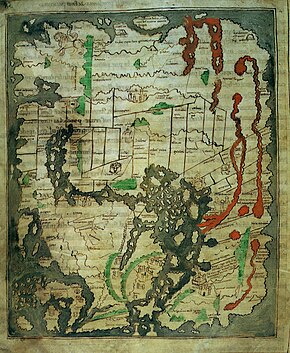
This map appears in a copy of a classical work on geography, the Latin version byPriscianof thePeriegesis,that was among the manuscripts in theCotton library(MS. TiberiusB.V., fol. 56v), now in theBritish Library.It is not intended purely as an illustration to that work, for it contains much material gathered from other sources, including some which would have been the most up-to-date available, although it is based on a distant Roman original (similar to the source ofanother 11th-century world map,illustrating an edition of Isidore of Seville) – on which the network of lines appears to indicate the boundaries ofimperialprovinces. The date of drawing was formerly estimated atc. 992–994CE, based on suggested links to the journey ofArchbishop Sigeric of Canterburyfrom Rome[25]but more recent analysis indicates that, although the information was revised about that time, the map was probably drawn between 1025 and 1050.[26]
Like the later map by al-Idrisi (see below) this map is clearly outside the largely symbolic early medieval mapping tradition, but equally it is not based on the famous Ptolemaic co-ordinate system. East is at the top, but Jerusalem is not in the centre, and the Garden of Eden is nowhere to be seen. Unusually, all the waterways of Africa, not just the Red Sea, are depicted in red (mountains are green). The depiction of the far East is ambitious, including India and Taprobane (Sri Lanka) – the latter depicted according to the exaggerated classical conception of its size. Unsurprisingly, Britain itself is depicted in some detail. Great Britain, unusually by medieval standards, is shown as one island, albeit with an exaggerated Cornish promontory, andMona,Ireland and the many Scottish islands are all indicated. The cartographer is slightly confused by Iceland, depicting it both by a version of its classical name 'Thule', north-west of Britain, and as 'Island', logically linked with Scandinavia.
An open-access high-resolution digital image of the map with place and name annotations is included among the thirteen medieval maps of the world edited in theVirtual Mappaproject.
Beatus Mappa Mundi (1050)
[edit]
Beatus of Liébana(c. 730–798) was anAsturianmonkandtheologian.He corresponded withAlcuin,and took part in theAdoptionistcontroversy, criticizing the views ofFelix of UrgelandElipandus of Toledo.He is best remembered today as the author of hisCommentary on theApocalypse,published in 776. An illustrated manuscript known as theSaint-Sever Beatus,featuring theCommentary,was produced around 1050 at the Abbey of Saint-Sever, Aquitaine, France. It contains one of the oldest Christian world maps as an illustration of theCommentary.Although the original manuscript and map has not survived, copies of the map survive in several of the extant manuscripts.
Mahmud al-Kashgari's Map (1072)
[edit]
QarakhanidUyghurscholarMahmud al-Kashgaricompiled aCompendium of the languages of the Turksin the 11th century. The manuscript is illustrated with a 'Turkocentric' world map, oriented with east (or rather, perhaps, the direction of midsummer sunrise) on top, centered on the ancient city ofBalasagunin what is nowKyrgyzstan,showing theCaspian Seato the north, andIraq,Armenia,YemenandEgyptto the west,ChinaandJapanto the east,Hindustan,Kashmir,Gog and Magogto the south. Conventional symbols are used throughout – blue lines for rivers, red lines for mountain ranges etc. The world is shown as encircled by the ocean.[27]The map is now kept at the Pera Museum in Istanbul.
Al-Idrisi'sTabula Rogeriana(1154)
[edit]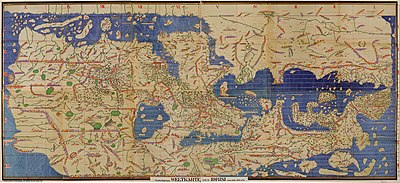
The Arab geographer,Muhammad al-Idrisi,incorporated the knowledge ofAfrica,theIndian Oceanand theFar Eastgathered byArab merchantsand explorers with the information inherited from the classical geographers to create the most accurate map of the world at the time. It remained the most accurate world map for the next three centuries. TheTabula Rogerianawas drawn by Al-Idrisi in 1154 for theNormanKingRoger II of Sicily,after a stay of eighteen years at his court, where he worked on the commentaries and illustrations of the map. The map, written in Arabic, shows theEurasiancontinent in its entirety, but only shows thenorthern partof the African continent.
Ebstorf Mappa Mundi (1235)
[edit]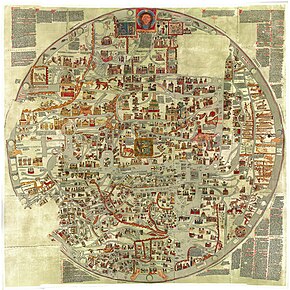
The Ebstorf Map was an example of a Europeanmappa mundi,made byGervase of Ebstorf,who was possibly the same man asGervase of Tilbury,[28]some time in the thirteenth century. It was a very large map: painted on 30 goatskins sewn together, it measured about 3.6 m × 3.6 m (12 ft × 12 ft). The head of Christ was depicted at the top of the map, with his hands on either side and his feet at the bottom.[29]The Map was a greatly elaborated version of the medieval tripartite orT and O map;it was centred on Jerusalem with east at the top of the map. It representedRomein the shape of a lion, and had an evident interest in the distribution of bishoprics.[30]The original was destroyed in the bombing ofHanoverin 1943 during World War II, but some photographs and colour copies remain.
Hereford Mappa Mundi (1300)
[edit]
TheHerefordMappa Mundiis a detailed mappa mundi based on theT and O mapstyle, dating toc. 1300.The map is signed by one "Richard ofHaldinghamorLafford".Drawn on a single sheet ofvellum,it measures 158 by 133 cm (62 by 52 in). The writing is in black ink, with additional red and gold, and blue or green for water (with theRed Seacoloured red). The captions demonstrate clearly the multiple functions of these large medieval maps, conveying a mass of information on Biblical subjects and general history, in addition to geography.
Jerusalemis drawn at the centre of the circle,eastis on top, showing theGarden of Edenin a circle at the edge of the world (1).Great Britainis drawn at the northwestern border (bottom left, 22 & 23). Curiously, the labels forAfricaandEuropeare reversed, with Europe scribed in red and gold as 'Africa', and vice versa.
An open-access high-resolution digital image of the map with more than 1,000 place and name annotations is included among the thirteen medieval maps of the world edited in theVirtual Mappaproject.
Pietro Vesconte's World Map (1321)
[edit]
Italian geographerPietro Vescontewas a pioneer of the field of theportolan chart.His nautical charts are among the earliest to map theMediterraneanandBlack Searegions accurately. He also produced progressively more accurate depictions of the coastlines of northern Europe. In his world map of 1321 he brought his experience as a maker of portolans to bear; the map introduced a previously unheard of accuracy to the mappa mundi genre.[31]The world map, as well as a map of theHoly Landand plan ofAcreandJerusalemwere made for inclusion inMarino Sanuto'sLiber Secretorum Fidelium Crucis.[32]
Catalan World Atlas (1375)
[edit]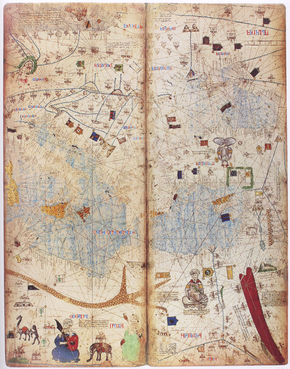
The Catalan World Atlas was produced by theMajorcan cartographic schooland is attributed toCresques Abraham.It has been in the royal library of France (now theBibliothèque nationale de France) since the time ofCharles V.The Catalan Atlas originally consisted of six vellum leaves folded down the middle, painted in various colours including gold and silver. The first two leaves contain texts in theCatalan languagecoveringcosmography,astronomy,andastrology.These texts are accompanied by illustrations. The texts and illustration emphasize the Earth's spherical shape and the state of the known world. They also provide information to sailors on tides and how to tell time at night.
Unlike many other nautical charts, the Catalan Atlas is read with the north at the bottom. As a result of this the maps are oriented from left to right, from the Far East to the Atlantic. The first two leaves, forming the oriental portion of the Catalan Atlas, illustrate numerous religious references as well as a synthesis of medieval mappae mundi (Jerusalem located close to the centre) and the travel literature of the time, notablyThe Travels of Marco Poloand theTravelsofSir John Mandeville.Many Indian and Chinese cities can be identified.
"Da Ming Hunyi Tu" world map (after 1389)
[edit]
TheDa Ming Hunyi Tu(Chinese:Đại minh trộn lẫn đồ;lit.'Amalgamated Map of the Great Ming Empire') world map, likely made in the late 14th or the 15th century,[33] shows China at the centre and Europe, half-way round the globe, depicted very small and horizontally compressed at the edge. The coast of Africa is also mapped from an Indian Ocean perspective, showing the Cape of Good Hope area. It is believed that maps of this type were made since about the 1320s, but all earlier specimens have been lost, so the earliest survivor is the elaborate, colourfulDa Ming Hunyi Tu,painted on 17 m2(180 sq ft) of silk.
Gangnido world map (1402)
[edit]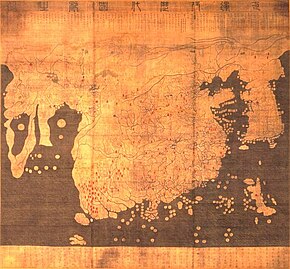
TheGangnido( "Map of Integrated Lands and Regions of Historical Countries and Capitals (of China)" )[34]is a world map and historical map of China, made inKoreain 1402, although extant copies, all in Japan, were created much later. It plays a key role in reconstructing the content of the now-lost 14th-century Chinese map of the world namedShengjiao Guangbei Tu,which was based on Chinese cartographic techniques with additional input from western sources, via Islamic scholarship in theMongol Empire.It also demonstrates the post-Mongol era stagnation of East Asian cartography as geographic information about the West was not updated until the introduction of European knowledge in the 16-17th centuries.[35]Superficially similar to theDa Ming Hun Yi Tu(which has been less well known in the West because it is kept in closed archive storage) the Gangnido shows its Korean origin in the enlargement of that country, and incorporates vastly improved (though wrongly positioned, scaled and oriented) mapping of Japan. Elsewhere, the map betrays a decorative rather than practical purpose, particularly in the portrayal of river systems, which form unnatural loops rarely seen on Chinese maps. Nonetheless, it is considered as "superior to anything produced in Europe prior to the end of the fifteenth century".[36]
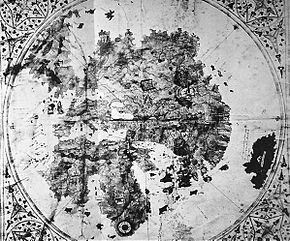
De Virga world map (1411–1415)
[edit]TheDe Virga world mapwas made by Albertinus de Virga between 1411 and 1415. Albertin de Virga, a Venetian, is also known for a 1409 map of the Mediterranean, also made in Venice. The world map is circular, drawn on a piece ofparchment69.6 cm × 44 cm (27.4 in × 17.3 in). It consists of the map itself, about 44 cm (17 in) in diameter, and an extension containing a calendar and two tables.
Bianco's world map (1436)
[edit]
Andrea Bianco's atlas of 1436 comprises ten leaves ofvellum,measuring 29 cm × 38 cm (11 in × 15 in), in an 18th-century binding. The first leaf contains a description of theRule of marteloiofor resolving the course, with the "circle and square", two tables and two other diagrams. The next eight leaves contain various navigation charts. The ninth leaf contains a circular world map measuring 25 cm (9.8 in) in circumference. And the final leaf contains the Ptolemaic world map on Ptolemy's first projection, with graduation. Some believe Bianco's maps were the first to correctly portray the coast of Florida, as a macro-peninsula is attached to a large island labeledAntillia.Bianco also collaborated withFra Mauroon the Fra Mauro world map of 1459.

Borgia world map (early 15th century)
[edit]Mainly a decoration piece, the Borgia map is a world map made sometime in the early 15th century, and engraved on a metal plate.
Genoese map (1457)
[edit]
TheGenoese mapof 1457 is aworld mapthat relied extensively on the account of the traveller to AsiaNiccolo da Conti,rather than the usual source ofMarco Polo.[37]The author is unknown, but is a more modern development than theFra Mauro world map,less intricate and complete, with fairly good proportions given to each of the continents. The map depicts the main landmarks of the time, and figures such as the legendaryPrester Johnin Africa, the Great Khan in China, "Xilam" (Ceylon) and Sumatra, and the design of a three-masted European ship in theIndian Ocean,something which had not occurred, suggesting that a sea-lane was a possibility.[37]

Fra Mauro world map (1459)
[edit]TheFra Mauro mapwas made between 1457 and 1459 by theVenetianmonkFra Mauro.It is a circular planisphere drawn onparchmentand set in a wooden frame, about 2 metres (6 ft 7 in) in diameter. The original world map was made by Fra Mauro and his assistant Andrea Bianco, a sailor-cartographer, under a commission by kingAfonso V of Portugal.The map was completed on April 24, 1459, and sent toPortugal,but did not survive to the present day. Fra Mauro died the next year while he was making a copy of the map for the Seignory of Venice, and the copy was completed by Andrea Bianco.
The map is preserved in theMuseo CorrerinVenice.
Martellus world map (1490)
[edit]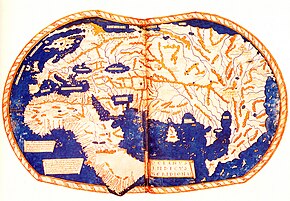
The world map ofHenricus Martellus Germanus(Heinrich Hammer), c. 1490, was remarkably similar to the terrestrial globe later produced byMartin Behaimin 1492, theErdapfel.Both show heavy influences fromPtolemy,and both possibly derive from maps created around 1485 in Lisbon byBartolomeo Columbus.Although Martellus is believed to have been born in Nuremberg, Behaim's home town, he lived and worked in Florence from 1480 to 1496.
Behaim'sErdapfelglobe (1492)
[edit]

TheErdapfel(German:earth apple) produced byMartin Behaimin 1492 is considered to be the oldest surviving terrestrialglobe.It is constructed of a laminated linen ball reinforced with wood and overlaid with amappainted ongoresbyGeorg Glockendon.[38]The Americas are not included yet, asColumbusreturned to Spain no sooner than March 1493. It shows a rather enlarged Eurasian continent and an empty ocean between Europe and Asia. It includes the mythicalSaint Brendan's Island.Japan and Asian islands are disproportionately large. The idea to call the globe "apple" may be related to theReichsapfel( "Imperial Apple",Globus cruciger) which was also kept in Nuremberg along with theImperial Regalia(Reichskleinodien). In 1907, it was transferred to theGermanic MuseuminNuremberg.
After 1492
[edit]Juan de la Cosa Map (1500)
[edit]
TheJuan de la Cosa,a Spanish cartographer,explorerandconquistador,born inSantoñain the northern autonomous region ofCantabria,made several maps of which the only survivor is theMappa Mundiof 1500. It is the first known European cartographic representation of theAmericas.It is now in theMuseo NavalinMadrid.Reproductions of it are given by Humboldt in hisAtlas géographique et physique.
Cantino Planisphere (1502)
[edit]
TheCantino planisphereor Cantino world map is the earliest surviving map showingPortuguesediscoveries in the east and west. It is named after Alberto Cantino, an agent for theDuke of Ferrara,who successfully smuggled it from Portugal toItalyin 1502. It shows the islands of theCaribbeanand what may be theFloridacoastline, as well as Africa, Europe and Asia. The map is particularly notable for portraying a fragmentary record of theBraziliancoast, discovered in 1500 by Portuguese explorerPedro Álvares Cabralwho conjectured whether it was merely an island[39]or part of the continent that severalSpanishexpeditions had just encountered farther north (cf.Amerigo Vespucci).
Caverio Map (c. 1505)
[edit]
TheCaverio Map,also known as the Caveri Map or Canerio Map, is a map drawn byNicolay de Caveri,c. 1505.It is hand drawn on parchment and coloured, being composed of ten sections or panels, measuring 2.25 by 1.15 metres (7.4 by 3.8 ft). Historians believe that this undated map signed with "Nicolay de Caveri Januensis" was completed in 1504–05. It was probably either made inLisbonby the Genoese Canveri, or copied by him inGenoafrom the very similarCantino map.It shows the east coast ofNorth Americawith surprising detail, and was one of the primary sources used to make theWaldseemüller mapin 1507. The Caverio map is currently at theBibliothèque Nationale de Francein Paris.
Ruysch World Map (1507)
[edit]
Johannes Ruyschan explorer, cartographer, astronomer and painter from theLow Countriesproduced the second oldest known printed representation of the New World.[40]The Ruysch map was published and widely distributed in 1507. It usesPtolemy's coniform projection, as does theContarini-Rosselli1506 map. Both documentChristopher Columbus' discoveries as well as that ofJohn Cabot,including information from Portuguese sources andMarco Polo's account. There are notes on his map that clearly were from Portuguese sources.NewfoundlandandCubaare shown connected to Asia, asColumbusandCabotbelieved. “Sipganus” (Marco Polo's Japan) is identical with “Spagnola” (Hispaniola) on the Ruysch map. The presence of codfish is noted on the Ruysch map in the area of theGrand BanksofNewfoundlandand shows the discoveries the Portuguese had made along the African coast and shows India as a triangular peninsula withCeylonin the correct proportion and position. Greenland is shown connected to Newfoundland and Asia on Ruysch's map, and not Europe as earlier maps had showed. Around the north pole, Ruysch drew islands, based on reports in the bookInventio Fortunataof the English friarNicholas of Lynne.The island above Norway shows remarkable similarities toSvalbard,which was not discovered until 1597 (byWillem Barents). Ruysch calls it 'European Hyberborea' and a peninsula stretching out towards it is clearly marked with the church of 'Sancti Odulfi', St Olaf's church inVardøon theFinnmarkcoast.
Waldseemüller and Ringmann map (1507)
[edit]
The cartographersMartin WaldseemüllerandMatthias Ringmannfrom southern Germany, supported by the mapping friendRené II, Duke of Lorraine,collected map data over several years, including information on the most recent discoveries, to build up a new collective work of geography and cartography. Along with a book they further incorporated, for the first time in history, the nameAmericaon a map, holding the strong opinion that it was a new continent thatAmerigo Vespuccihad discovered on his voyage and not only a few smaller islands asChristopher Columbusdid in theWest Indies.
Piri Reis Map (1513)
[edit]
ThePiri Reis mapis a famous world map created by 16th-centuryOttoman Turkishadmiral and cartographerPiri Reis.The surviving third of the map shows part of the western coasts of Europe and North Africa with reasonable accuracy, and the coast ofBrazilis also easily recognizable. Various Atlantic islands including theAzoresandCanary Islandsare depicted, as is the mythical island ofAntillia.The map is noteworthy for its apparent south-eastward extension of the American continent to depict a southern landmass that some controversially claim is evidence for early awareness of the existence ofAntarctica.Alternatively, it has been suggested that this is actually a record of the coast as far asCape Horn,explored secretly by Portuguese navigators before 1507 (when it appeared on theWaldseemüller map) and bent south-eastward simply to fit on the parchment.
Pietro Coppo Map (1520)
[edit]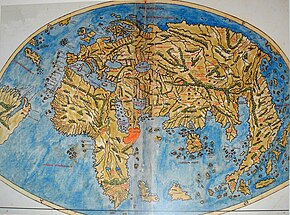
The map byPietro Coppowas one of the last world maps to feature the "Dragon's Tail"extending southwards from the far eastern extremity of Asia, the last vestige of Ptolemy's landlocked depiction of the Indian Ocean, nearly 1,500 years earlier.
Padrón Real (1527)
[edit]The editions of theSpanishroyal standard map(Padrón RealorGeneral) overseen byDiogo Ribeiroin the 1520s and 1530s are considered to be the first scientific world maps based on empiric latitude observations. Europe andCentralandSouth Americaare very precisely delineated, although Portuguese control of the African trade routes limited the accuracy of information on the Indian Ocean. Incorporating information from theMagellan,Gomes,andLoaysa expeditionsandgeodesicresearch undertaken to establish the demarcation line of the 1494Treaty of Tordesillas,the maps show for the first time the real extension of thePacific Oceanand the continuous coast ofNorth America.
The originals are now lost but six copies of known provenance have survived.[41]The 1525 Castiglione Map is now held by theEstense LibraryinModena,Italy;the 1526Salviati Planisphereis held by theBiblioteca Medicea LaurenzianainFlorence;the 1527 Weimar Map is held by theAnna Amalia BibliothekinWeimar,Germany;and the 1529PropagandaMap is held by theVatican Library.[41]Detailed copies of the Propaganda Map were made in the 19th century byWilliam Griggs.
-
1525 Castiglione Map
-
1527 Weimar Map
-
1529 Propaganda Map
Mercator world map (1569)
[edit]
Flemishgeographer and cartographerGerardus Mercatorworld map of 1569 introduced acylindrical map projectionthat became the standard map projection known as theMercator projection.It was a large planisphere measuring 202 by 124 cm (80 by 49 in), printed in eighteen separate sheets. While the linear scale is constant in all directions around any point, thus preserving the angles and the shapes of small objects (which makes the projectionconformal), the Mercator projection distorts the size and shape of large objects, as the scale increases from the Equator to the poles, where it becomes infinite. The title (Nova et Aucta Orbis Terrae Descriptio ad Usum Navigatium Emendate:"new and augmented description of Earth corrected for the use of navigation" ) and themap legendsshow that the map was expressly conceived for the use of marine navigation. The principal feature of the projection is thatrhumb lines,sailing courses at a constant bearing, are mapped to straight lines on the map. The development of the Mercator projection represented a major breakthrough in the nautical cartography of the 16th century although it was only slowly adopted by seafaring nations.
Theatrum Orbis Terrarumby Abraham Ortelius (1570)
[edit]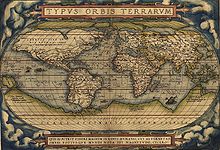
TheTheatrum Orbis Terrarum(or "Theatre of the World" ) is considered to be the first true modernatlas.Prepared byAbraham Orteliusand originally printed on May 20, 1570 inAntwerp,it consisted of a collection of uniformmapsheets and sustaining texts bound to form a book for which copper printing plates were specifically engraved. The Ortelius atlas is sometimes referred to as the summary of sixteenth-centurycartography.Many of his atlas's maps were based upon sources that no longer exist or are extremely rare. Ortelius appended a unique source list (the "Catalogus Auctorum" ) identifying the names of contemporary cartographers, some of whom would otherwise have remained obscure. ThreeLatineditions of this (besides aDutch,aFrenchand aGermanedition) appeared before the end of 1572; twenty-five editions came out before Ortelius's death in 1598; and several others were published subsequently, as the atlas continued to be in demand until approximately 1612.
Die ganze Welt in einem Kleberblatby Heinrich Bünting (1581)
[edit]
TheBünting Clover Leaf Map,also known asThe World in a Cloverleaf(Germantitle:Die ganze Welt in einem Kleberblat/Welches ist der Stadt Hannover meines lieben Vaterlandes Wapen) is an historicmappa mundidrawn by theGermanProtestantpastor,theologist,andcartographerHeinrich Bünting.The map was published in his bookItinerarium Sacrae Scripturae(Travel through Holy Scripture) in 1581.
Today the map is found within the Eran Laor maps collection in theNational Library of IsraelinJerusalem.A mosaic model of the map is installed on the fence ofSafra Squareat the site of Jerusalem's city hall.
The map is a figurative illustration, in the manner of the medieval mappa mundi format, depicting the world via aclovershape.[42]The shape is a symbolisation of theChristianTrinityand a component at the symbolisation of the German cityHanover,where Bünting was born. The city of Jerusalem is represented as the centre, surrounded by three central continents, with some more areas of the world being accordingly illustrated separately from the clover.
"Kunyu Wanguo Quantu" by Matteo Ricci (1602)
[edit]
Kunyu Wanguo Quantu (Chinese:Khôn dư vạn quốc toàn bộ bản đồ;lit.'A Map of the Myriad Countries of the World';Italian:Carta Geografica Completa di tutti i Regni del Mondo,"Complete Geographical Map of all the Kingdoms of the World" ), printed by ItalianJesuitmissionaryMatteo Ricciat the request byWanli Emperorin 1602, is the first known European-styled Chinese world map (and the first Chinese map to show theAmericas). The map is inClassical Chinese,with detailed annotations and descriptions of various regions of the world, a brief account of the discovery of the Americas,polar projections,scientific explanation of parallels and meridians, and proof that the Sun is bigger than the Moon. Following Chinese cartographical convention, Ricci placed China ( "the Middle Kingdom" ) at the centre of the world. This map is a significant mark of the expansion of Chinese knowledge of the world, and an important example ofcultural syncretismdirectly between Europe and China. It was also exported toKoreaandJapanas well.[43]
Hendrik Hondius map (1630)
[edit]
Nova Totius Terrarum Orbis Geographica ac Hydrographica Tabulais a map of the world created byHendrik Hondiusin 1630, and published the following year atAmsterdam,in the atlasAtlantis MaiorisAppendix. Illustrations of the four elements of fire, air, water, and land are included. In the four corners, there are portraits ofJulius Caesar,Claudius Ptolemy,and the atlas's first two publishers,Gerard MercatorandJodocus Hondius,the father of Hendrik.[44]Among its claims to notability is the fact that it was the first dated map published in an atlas, and therefore the first widely available map, to show any part of Australia, the only previous map to do so beingHessel Gerritsz' 1627Caert van't Landt van d'Eendracht( "Map of theLand of Eendracht"), which was not widely distributed or recognised. The Australian coastline shown is part of the west coast of Cape York Peninsula, discovered byJan Carstenszin 1623. Curiously, the map does not show the west coast features shown in Gerritsz' Caert.
Shahid-i Sadiq (1647)
[edit]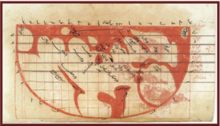
TheShahid-i Sadiqwas an atlas composed by Sadiq Isfahani inJaunpur.[45]This included theInhabited Quarter,a map of the parts of the world which he held to be suitable for human life.[46]This is one of the only surviving maps made in India. The map stretched from the Insulae Fortunatae (Canary Islands) in the top right to Andalusia (Europe) to Sus al Aqsa (Western Africa) in the left.[45]TheShahid-i Sadiqincluded The 32 sheet atlas—with maps oriented towards the south as was the case with Islamic works of the era—is part of a larger scholarly work compiled by Isfahani during 1647.[46]This map measures 661 × 645 cm. (260 × 254 in., or approximately 22 × 21 ft).[47]
Nicolaes Visscher map (1658)
[edit]
This engraved double hemisphere map,Orbis Terrarum Nova et Accuratissima Tabula,was created byNicolaes Visscherin 1658 inAmsterdam.It also contains smaller northern and southern polar projections. The border is decorated with mythological scenes, one in each corner, drawn by the painterNicolaes Berchem,showingZeus,Neptune,PersephoneandDemeter.It is an early example of highly decorated Dutch world maps.[48][49]
Gerard van Schagen's Map of the World (1689)
[edit]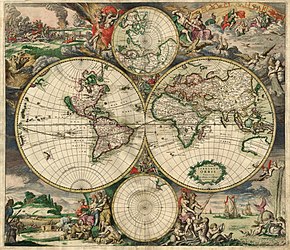
Gerard van Schagen (c. 1642–1724?) was acartographerfromAmsterdam,known for his exquisite reproductions of maps, particularly of those byNicolaes Visscher IandFrederick de Wit.[50][51][52]The map is of 1689. The original size is 48.3 cm × 56.0 cm (19.0 in × 22.0 in) and was produced using copper engraving. There is only one known example, which is in theAmsterdam University.
Tovmas Vanandetsi world map (1695)
[edit]
Hamatarats Ashkharhatsuyts (Geographic Map of the World),[53]was produced in 1695 inAmsterdamby the Armenian printing firm founded byTovmas Vanandetsi.At the time, one of the most reliable maps of the two hemispheres was the first large-scale map drawn inArmenian.[54]The world map was created in a Westerncartographicstyle. To engrave the map's copper plates, the Schoonebeek brothers, who were considered the best masters, were employed. The map is divided into eight sections, totaling 150 × 120 cm in size. The different portions of the map were adhered to a thin canvas to guard against damage during folding. The map has conventional, astrological, and mythical symbols representing the four seasons in each of its four corners.
Samuel Dunn's map of the world (1794)
[edit]
Samuel Dunn(died 1794) was a Britishmathematicianand amateur astronomer. His map covers the entire world in a double hemisphere projection. This map follows shortly after the explorations ofCaptain Cookin the Arctic and Pacific Northwest, so the general outline of North America is known. However, when this map was made, few inland expeditions had extended westward beyond theMississippi River.[55]Antarcticais noticeably absent, which is of particular note, as earlier maps had depicted an imagined Antarctica, as early as 1570 in the West byAbraham Ortelius,and 1602 in the Far East. These images were speculative, as Antarctica had not then been proven to exist.
See also
[edit]- Cylcon,Aboriginal Australian cylindro-conical stones some of which are thought to contain maps
- Dieppe maps,a series of 16th-century world maps produced in Dieppe, France
- "Here be dragons",a phrase indicating uncharted areas
- History of cartography
- Jambudvīpa,a geographic idea originated in India
- Johannes Schöner globe,made in 1520
- Mappa mundi,medieval European maps of the world
- Nebra sky disc,a Bronze Age "map" of the cosmos
- Terra incognita,uncharted territories documented in early maps
- Vinland Map,a claimed 15th-century map later confirmed as a 20th-century forgery
- Virtual Mappa,a project to digitise medievalmappa mundi
- Mao Kun map,also called Zheng He's navigation map, a world map dated to the 17th century but thought to be a copy of an early 15th-century map
Notes
[edit]- ^Gershon, Livia."Is This 4,000-Year-Old Bronze Age Slab the Oldest Known Map in Europe?".Smithsonian Magazine.Retrieved9 April2021.
- ^"La plus ancienne carte d'Europe?".Inrap(in French). 6 April 2021.Retrieved9 April2021.
- ^"Bronze Age slab found in France is oldest 3D map in Europe".BBC News.6 April 2021.Retrieved14 April2021.
- ^Nicolas, C.; Pailler, Y.; Stephan, P.; Pierson, J.; Aubry, L.; Le Gall, B.; Lacombe, V.; Rolet, J. (April 2021)."La carte et le territoire: la dalle gravée du Bronze ancien de Saint-Bélec (Leuhan, Finistère)".Bulletin de la Société préhistorique française(in French).118(1): 99–146.Retrieved14 April2021.
- ^British Museum Inv. No. 92687:"6th C BC approx". See also: Siebold, Jim.Slide 103.Archived2016-11-09 at theWayback Machine.Via henry-davis – accessed 2008-02-04. First published 1899, formerly also dated to an earlier period,c. 900BCE.Raaflaub, Kurt A.; Talbert, Richard J. A. (2009).Geography and Ethnography: Perceptions of the World in Pre-Modern Societies.John Wiley & Sons.p. 147.ISBN978-1-4051-9146-3.
- ^Smith, Catherine Delano (1996). "Imago Mundi's Logo the Babylonian Map of the World".Imago Mundi.48:209–211.doi:10.1080/03085699608592846.JSTOR1151277.
- ^Finel, Irving (1995).A join to the map of the world: A notable discovery.pp. 26–27.
- ^"Timechart of historical cartography: Antiquity".Archived from the original on 25 February 2021.
{{cite web}}:CS1 maint: unfit URL (link) - ^"World map according to Eratosthenes (194 B.C.)".Archived from the original on 13 August 2021.
{{cite web}}:CS1 maint: unfit URL (link) - ^"Poseidonius".Encyclopædia Britannica."Greek philosopher, considered the most learned man of his time and, possibly, of the entire Stoic school."
- ^Poseidonius,fragment 202
- ^Brown, Lloyd Arnold (1979).The Story of Maps.Dover Publications. pp. 29–31.
- ^Freely, John(2013).Before Galileo: The Birth of Modern Science in Medieval Europe.ISBN978-1468308501.
- ^Strabonis Geographica,Book 17, Chapter 7.
- ^Vat. Urbinas Graecus82.
- ^Codex SeragliensisGI 57
- ^abSnyder, John P. (1993),Flattening the Earth: Two Thousand Years of Map Projections,Chicago: University of Chicago Press, p. 14,ISBN978-0226767475
- ^Eastwood, B., and Graßhoff, G. (2004). "Planetary Diagrams for Roman Astronomy in Medieval Europe, ca. 800–1500".Transactions of the American Philosophical Society94:3. pp. 49–50.
- ^Macrobius,Commentary on the Dream of Scipio,transl.W. H. Stahl,(New York: Columbia University Press, 1952), chapters v-vii (pp. 200–212).
- ^Michael Livingston,Modern Medieval Map Myths: The Flat World, Ancient Sea-Kings, and DragonsArchived2006-02-09 at theWayback Machine,2002.
- ^"Focus sur... La Mappa mundi d'Albi".mediatheques.grand-albigeois.fr(in French).
- ^"La" Mappa mundi d'Albi "a rejoint en octobre 2015 le registre" Mémoire du monde "de l'Unesco".culture.fr(in French)..
- ^"Présentation de la Mappa Mundi d'Albi".youtube(in French). 4 February 2016.Archivedfrom the original on 21 December 2021.
- ^The History of cartographyby John Brian Harley, David Woodward pp. 120ff
- ^Siebold, JimSlide 210 monograph: Cottoniana or Anglo-Saxon MapArchived2018-07-30 at theWayback Machine,via henry-davis - accessed 2008-02-04
- ^British LibraryCollect BritainArchived2009-04-28 at theWayback Machine,accessed 2008-03-14
- ^81 – The First Turkish World Map, by Kashgari (1072) « Strange Maps
- ^Gervase of Tilbury,Otia Imperialia,(Oxford Medieval Texts), Oxford, 2002, p. xxxiv.
- ^Edson, Evelyn (1997).Mapping Time and Space: How Medieval Mapmakers viewed their World.London: British Library. p. 138.ISBN0-7123-4535-3.
- ^Gervase of Tilbury,Otia Imperialia,(Oxford Medieval Texts), Oxford, 2002, p. xxxv
- ^"Vesconte World Maps".Archived from the original on 17 February 2020.
{{cite web}}:CS1 maint: unfit URL (link) - ^Harley, John Brian; Woodward, David, eds. (1987).The History of Cartography.Chicago: University of Chicago Press.ISBN0-226-31633-5.[permanent dead link]
- ^ The place names on the map reflect the political situation in 1389, or the 22nd year of the reign of theHongwu Emperor.Thus some Chinese scholars concluded that it was indeed created in 1389 or little later (Wang et al.,Juanben caihui Daming Hunyi Tu yanjiuTranh lụa hoa văn màu đại minh trộn lẫn đồ nghiên cứu (As Regards the Da Ming Hun Yi Tu Drawn in Colours on Stiff Silk), in:Zhongguo gudai dituji: Ming daiTrung Quốc cổ đại bản đồ tập đời Minh (An Atlas of Ancient Maps in China: The Ming dynasty (1368–1644)), Beijing, 1994, pp. 51–55). Others maintain that this reflects an earlier source and that theDa Ming Hun Yi Tuitself was created much later (Miya Noriko, "Kon'itsu Kyōri Rekidai Kokuto no Zu" he no michi “Trộn lẫn cương lý lịch đại thủ đô chi đồ” へ の nói,Mongoru jidai no shuppan bunkaモンゴル thời đại の xuất bản văn hóa, 2006, 487–651 (pp. 511–512).
- ^abRobinson, Kenneth R. (2007). "Chosŏn Korea in the Ryukoku Kangnido: Dating the Oldest Extant Korean Map of the World (15th Century)".Imago Mundi.59(2): 177–192.doi:10.1080/03085690701300964.S2CID128416415.
- ^Miya Noriko cung kỷ tử (2006). "Kon'itsu Kyōri Rekidai Kokuto no Zu" he no michi “Trộn lẫn cương lý lịch đại thủ đô chi đồ” へ の nói ".Mongoru jidai no shuppan bunka モンゴル thời đại の xuất bản văn hóa(in Japanese). pp. 487–651.
- ^Jackson, Peter (2005).The Mongols and the West.New York: Pearson Longman. p. 330.ISBN0-582-36896-0.
- ^abWhitfield, Peter (1998).New Found Lands: Maps in the History of Exploration.New York: Routledge. p.36.ISBN0-415-92026-4.
- ^Behaim Globe at Bayern-online
- ^Letter of Pero Vaz de Caminha,beijo as maãos de vosa alteza. deste porto seguro da vosa jlha da vera cruz(see original letter in archaic Portuguese,in the Portuguese Wikisource project):I kiss Your Majesty's Hands,from this safe haven of your island of Vera Cruz
- ^McGuirk, Donald L. Jr. (1989). "Ruysch World Map: Census and Commentary".Imago Mundi.41(1): 133–141.doi:10.1080/03085698908592674.
- ^abRibero, Diego."Carta Universal".Archived from the original on 9 November 2020.
{{cite web}}:CS1 maint: unfit URL (link) - ^Genevieve Carlton (2015).Worldly Consumers: The Demand for Maps in Renaissance Italy.University of Chicago Press. p. 42.ISBN978-0-226-25545-3.
- ^Rothstein, Edward (19 January 2010)."Map That Shrank the World".New York Times, Arts, Exhibition Review.New York: New York Times Company.Retrieved20 January2010.
- ^"Nova totius terrarum orbis geographica ac hydrographica tabula".Norman B. Leventhal Map Center.
- ^abIsfahani, Sadiq (1647)."Map of the" Inhabited Quarter ""(PDF).
- ^abSchwartzberg, 1302
- ^Schwartzberg, 1303
- ^"Visscher, Nicolaes (1618–1679). Orbis Terrarum Nova et Accuratissima Tabula. Amsterdam: 1658".Christie's.
- ^"Orbis Terrarum Nova et Accuratissima Tabula, 1658".Commonwealth Bank of Australia.
- ^"van Schagen 1680 World & Continents".Archived fromthe originalon 10 April 2016.Retrieved9 October2016.
- ^Catalog of van Schagen's mapsat theUniversity of Amsterdam
- ^Biographical sketch(in Dutch)
- ^"RareMaps".
- ^"Art-A-Tsolum".21 August 2023.
- ^Gordon Goodwin: "Dunn, Samuel (d.1794)" in Leslie Stephen,Dictionary of National Biography,16, London, 1888, 211–213.
Further reading
[edit]- Brodersen, Kai (2012). "Chapter 4: Cartography".Geography in Classical Antiquity.By Dueck, Daniela. Cambridge: Cambridge Univ. Press. pp. 99–110.ISBN9780521197885.
- Edson, Evelyn (1993). "The Oldest World Maps: Classical Sources of Three Eighth Century Mappaemundi".Ancient World.24(2): 169–184.
- Fox, Michael; Reimer, Stephen R (2008).Mappae Mundi: Representing the World and Its Inhabitants In Texts, Maps, and Images In Medieval and Early Modern Europe.Edmonton: Department of English and Film Studies, University of Alberta.ISBN9781551951874.OCLC227019112.
- Goffart, Walter (2003).Historical Atlases: The First Three Hundred Years, 1570–1870.Chicago: Univ. of Chicago Press.ISBN9780226300726.OCLC727367115.
- Harwood, Jeremy; Bendall, A. Sarah (2006).To the Ends of the Earth: 100 Maps That Changed the World.Cincinnati, OH: David & Charles.ISBN9781582974644.OCLC75546416.
- Harvey, Paul D.A., ed. (2006).The Hereford World Map: Medieval World Maps and their Context.London: British Library.ISBN9780712347600.OCLC0712347607.
- Shirley, Rodney W. (1993).The Mapping of the World: Early Printed World Maps 1472–1700.London: Holland Press.ISBN9781853682711.OCLC29389647.
- Talbert, Richard J.A., ed. (2000).Barrington Atlas of the Greek and Roman World.Princeton, NJ: Princeton Univ. Press.ISBN9780691031699.OCLC43970336.
- Wendt, Henry; Delaney, John; Bowles, Alex (2010).Envisioning the World: The First Printed Maps 1472–1700.Santa Rosa, CA: Sonoma County Museum.OCLC617728973.
- Woodward, David (1985). "Reality, Symbolism, Time, and Space in Medieval World Maps".Annals of the Association of American Geographers.75(4): 510–521.doi:10.1111/j.1467-8306.1985.tb00090.x.
External links
[edit]![]() Media related toMaps of the world before Columbusat Wikimedia Commons
Media related toMaps of the world before Columbusat Wikimedia Commons
- Index of Maps of the Early Medieval Period – HenryDavisArchived2007-03-12 at theWayback Machine
- Mapping History– resource from the British Library
- Geography and Map Reading Room at the Library of Congress
- Ancient World Maps
- The Peutinger Map
- Virtual Mappa:Digital Editions of Early Medieval Maps of the World, edit. Martin Foys, Heather Wacha, et al. (Philadelphia, PA: Schoenberg Institute of Manuscript Studies, 2018):doi:10.21231/ef21-ev82
- Medieval Maps and Mapping Resources




